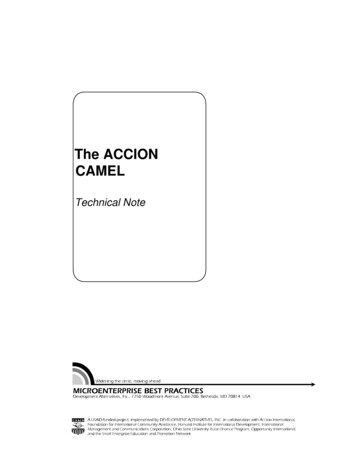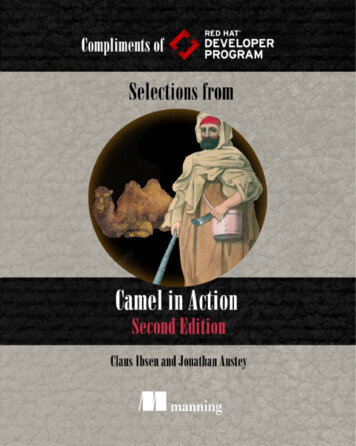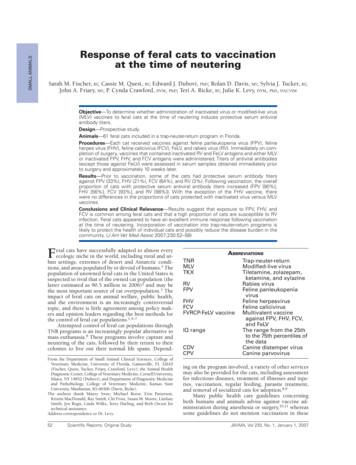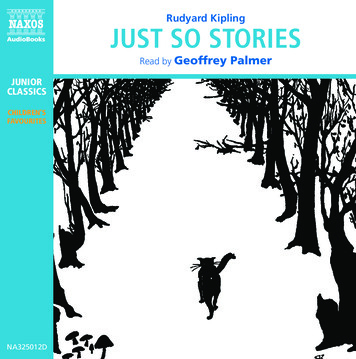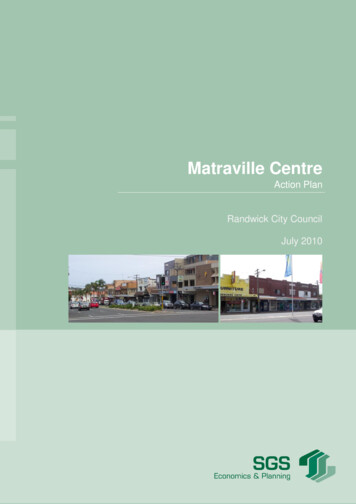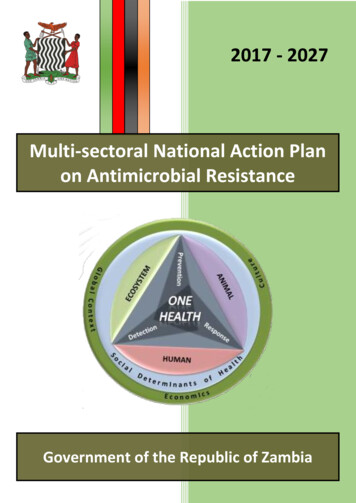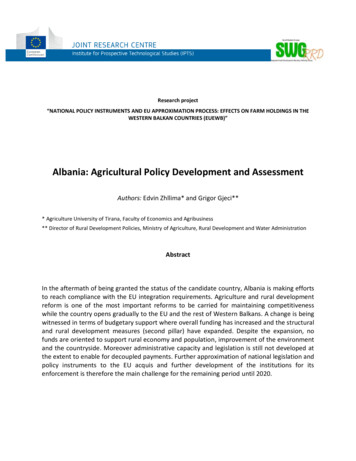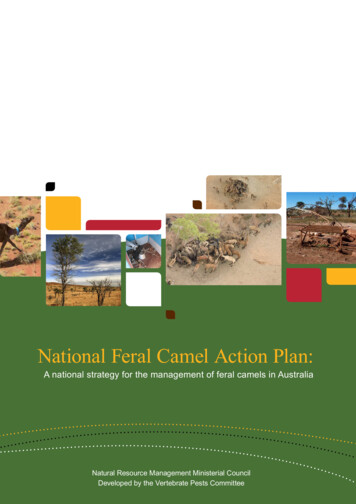
Transcription
National Feral Camel Action Plan:A national strategy for the management of feral camels in AustraliaNatural Resource Management Ministerial CouncilDeveloped by the Vertebrate Pests Committee
DisclaimerThe Australian Government, Department of Sustainability, Environment, Water, Population and Communities has collated and edited this publication forthe Natural Resources Management Ministerial Council. While reasonable efforts have been made to ensure that the contents of this publication arefactually correct, the Australian Government and members of the Natural Resources Ministerial Council (and the governments which Council membersrepresent) do not accept responsibility for the accuracy or completeness of the contents, and shall not be liable for any loss or damage that may beoccasioned directly or indirectly through the use of, or reliance on, the contents of this publication. Commonwealth of Australia 2010This work is copyright. You may download, display, print and reproduce this material in unaltered form only (retaining this notice) for your personal, noncommercial use or use within your organisation. Apart from any use as permitted under the Copyright Act 1968, all other rights are reserved. Requestsand inquiries concerning reproduction and rights should be addressed to Commonwealth Copyright Administration, Attorney General’s Department,Robert Garran Offices, National Circuit, Barton ACT 2600 or posted at www.ag.gov.au/ccaCover images, Front L to R:Collared camel - Department of Agriculture and Food, WADamaged vegetation at Docker River - Central Land Council, NTBroken toilet - Department of Agriculture and Food, WACamels around waterhole at Docker River - R. Bugg, NTCamels around waterhole at Docker River - R. Bugg, NTWindmill - B. Zeng, Dept Natural Resources, Environment, the Arts and Sport, NT
National Feral Camel Action PlanExecutive summaryThere are currently over one million feral camels in the rangeland ecosystems ofAustralia. Feral camels are causing significant damage to the natural environment aswell as to social, cultural and economic values across their extensive range. If leftunmanaged, the number of feral camels will double in the next 8–10 years and feralcamels will expand into new areas. If this happens, the extent and magnitude of thedamaging impacts of feral camels will increase.Management of feral camels and their impacts across the rangelands (primarilyconsisting of Aboriginal, conservation, pastoral and crown lands) is a complex issuethat has two significant challenges: the rapid reduction of the currently over-abundant feral camel population, and building a legacy that will sustain on-going protection of assets and values ofthe rangelands.There is a substantial number of stakeholders in feral camel management, includinggovernments, landowners and landholders, communities and individuals, and thosewith commercial interests in feral camels. In order to achieve a significant reductionof the negative impacts of the feral camel population, all these groups will have towork together. However, there are differing views on how feral camels should bemanaged to achieve this outcome.The National Feral Camel Action Plan (the National Plan) has been developed toguide the management of feral camels now and into the future. It provides a strategicand risk-based approach upon which local, regional and state-based management offeral camels can be undertaken. The National Plan’s vision is:Comprehensive, coordinated and humane management of feral camels andtheir impacts that maintains and promotes the biodiversity, agriculturalassets and social values of our rangelands for all Australians.The four key outcomes identified for the National Plan are the: development of the Australian and international community’s understandingof and support for the humane management of feral camels and their impacts amelioration of the negative impacts of feral camels by addressing the currentover-abundance of feral camels through the immediate, substantial andsustained reduction in their numbers and impacts across the rangelands adoption of a platform for the on-going humane management of feral camels,and development of partnerships and social capacities for feral camel managementinto the future.The National Plan has been developed as a management plan for an Existing PestAnimal of National Significance (EPANS) under the Australian Pest Animal Strategy(APAS). A Feral Camel Working Group of the Vertebrate Pests Committee willoversee the implementation of the National Plan.1
Table of 5.45.56A1A2A3VisionChallengesWhy a national plan?What are the negative impacts of feral camels?Primary stakeholdersSecondary stakeholdersKey outcomesProcess to be followedDevelopment of the draft National PlanPublic comment and endorsementImplementationBackgroundCamel ecology and biologyHistory of spreadAnnotated bibliography of camel-relatedresearch in AustraliaControl methodsSocio-economic factors affecting managementdecisionsNational Action PlanSummary matrixThe National Feral Camel Action Plan: goals,actions and the strategy for implementationGoal 1 – The Australian public andinternational community understand the needfor and support the humane management offeral camels and their impactsGoal 2 – Mitigation of the negative impactsbeing caused by the current overabundance offeral camelsGoal 3 – Adoption of a platform for ongoinghumane management of feral camelsGoal 4 – Partnerships and social capacity forhumane camel management are in placeAppendicesAustralian Pest Animal Strategy – KeyprinciplesCamel management stakeholdersFeral camel control methodsConsulted 232465258585961672
1.VisionFeral camels are wild camels that roam long distances across Australia’s rangelandecosystems. The National Feral Camel Action Plan (the National Plan) has beendeveloped in response to the increasing number of feral camels, their increasingdamage to the natural environment, community infrastructure, cultural sites andprimary industries and the need for a nationally coordinated approach to dealing withthese issues. The vision for the National Plan is:Comprehensive, coordinated and humane management of feral camelsand their impacts that maintains and promotes the biodiversity,agricultural assets and social values of our rangelands for all Australians.Throughout this plan, the term “rangelands” refers to the arid ecosystems acrosscentral and western Australia. Such ecosystems are primarily a mix of Aboriginal,conservation, pastoral and crown lands.The National Plan is not about farmed camels that are deliberately fenced in forproductive or other purposes or that are under the control of a person or company.2.ChallengesManagement of feral camels across the Australian rangelands is a complex issue.There are currently over one million feral camels and this population will double inthe next 8-10 years and beyond. At this population level feral camels are havingsignificant negative impacts across their extensive range and are expanding into newareas. These impacts are environmental, social, cultural and economic. Theoverarching challenges for the National Plan are to set a framework that will: enable rapid and humane reduction of the currently over-abundant feral camelpopulation to a level where it does not threaten the integrity of assets andsocial values and where jurisdictions and landowners can readily undertakeon-going management to protect these assets and values, and ensure there is a legacy or platform in place that will sustain on-goingprotection of these assets and values from feral camels.These central challenges are complicated by the array of other challenges that theimplementation of the National Plan faces.The feral camel range extends across three states (Western Australia, South Australia,Queensland) and the Northern Territory. Each jurisdiction has legislative andregulatory frameworks for the management of all pest animals including feral camels,which landholders must abide by. However, the detailed requirements of theseframeworks have not been harmonised across jurisdictional boundaries. To date therehas been little cooperative, cross-jurisdictional feral camel management except on asmall scale ad hoc basis. This limited cross-jurisdictional effort has had little impacton feral camel populations overall, and has been ineffective in mitigating theirimpacts across Australia’s rangelands. The jurisdictions are facing a considerablechallenge to: harmonise legislative and regulatory requirements for feral camel control,and/or develop appropriate protocols to both allow and encourage cross jurisdictionalferal camel management, and3
implement mechanisms to deal with the management of feral camels acrossdifferent land tenures (e.g. pastoral, government and Aboriginal) when theapproach required needs to access all tenures.The values that are held by individuals and stakeholder groups about feral camels varyconsiderably. For some groups the negative impacts that feral camels have onenvironmental, social and cultural values are highly significant. Similarly, theeconomic costs associated with damage to infrastructure (such as fences) caused byferal camels and expenditure required to manage feral camels is a significant impostto land managers. Alternatively some communities and individuals see that feralcamels are a potential economic resource that could be harnessed providing localemployment and income. Further, the value of feral camels as a protein resource thatcould contribute towards a need in the world context is also valued by someindividuals and groups. The challenges faced by the jurisdictions given this broadarray of values include the: engagement of the different interest groups/stakeholders in the need for, and toundertake, action to manage the negative impacts of feral camels development via partnerships of appropriate capacities amongst stakeholdersto manage feral camels and their impacts in a variety of settings and through avariety of control mechanisms countering of inaccurate and misrepresentative domestic and internationalinformation which condemns or interferes with the implementation of theNational Plan, and identification and implementation of processes to address regulatory barriersto the development of commercial camel use, enterprises and/or industries.A great deal of research has been undertaken on the ecology of feral camels and thishas been synthesised by the Desert Knowledge Cooperative Research Centre(DKCRC) in recent years. This has provided a significant base of knowledge uponwhich sound management decisions can be based. Nevertheless, there are gaps in thisknowledge in respect of impacts, potential control methods and in capacities to predictchanges in population distribution and densities. However, waiting for research toaddress these knowledge gaps is not a justifiable reason to stop immediate actiontowards the humane management of feral camels and their impacts.The National Plan has been developed using the 12 principles of the Australian PestAnimal Strategy (see Appendix A1) in order to bring together an agenda of short,medium and long-term actions and those responsible for undertaking them. Thegoals, objectives and actions listed are of an aspirational nature and the National Planis dependent upon the jurisdictions and other stakeholders that are involved adoptingand pursuing the actions for which they are responsible. The National Plan does nothave a statutory basis.2.1Why a national plan?The current management of feral camels is largely ad hoc and is fragmented byjurisdictional and tenure boundaries. Consequently, feral camel management to datehas failed to provide a strategic and risk-based approach upon which local, regionaland state-based management can be undertaken.In order to develop a strategic and risk-based approach to feral camelmanagement, an overarching emphasis has to be placed on humane managementtechniques and the mitigation of the impacts of feral camels at appropriatescales, rather than simply reducing feral camel numbers. However, as there is a4
positive relationship between feral camel density and degree of damage, reducingferal camel numbers is an important strategy in achieving damage mitigation.Further, mitigation of the negative impacts of feral camels requires immediate effortby all - governments, industries, land managers and the various stakeholdercommunities.This can only be achieved by providing a framework at a national level as: the current large population of feral camels occurs over a vast area feral camels are highly mobile and are able to move over large distances inrelatively short time periods feral camels occur in very remote areas that are sparsely populated by humansand where ground access may be extremely limited or non-existent there are differing perceptions on feral camels and their impacts. Feral camelsare considered to be both a pest and a resource and on occasion an ‘icon’.The current distribution of the feral camel covers much of arid Australia – see Figure1. Feral camels are present in up to 50 per cent of Australia’s rangelands ecosystems,which includes most of the arid regions of Western Australia, South Australia, theNorthern Territory and parts of Queensland. Table 1 shows each of the jurisdictionswhere feral camels are present and the percentage of the total feral camel range that isin each jurisdiction.Figure 1. Australian rangelands showing estimated distribution of feral camels in2008 and the location of the dog fence (from Report 47 “Managing the impacts offeral camels in Australia: a new way of doing business”, Desert Knowledge CRC).Table 1. The area occupied by feral camels in each jurisdictions across the feralcamel range5
JurisdictionWestern AustraliaNorthern TerritorySouth AustraliaQueenslandTotalArea within feral cameldistribution ntage feral camelrange in jurisdiction4626.317.7101002.2What are the negative impacts of feral camels?Feral camels are found over a variety of land tenures. The key landholders/mangersacross the feral camel range are conservation agencies (manage 10 per cent of landwithin the camel range), Aboriginal landholders (23.5 per cent) and pastorallandholders (24.5 per cent) (see Table 2). The remaining land on which camels occuris largely classed as unallocated crown land, much of which is subject to native landtitle claim. While the negative impacts of feral camels are generally the same acrossland tenures, perceptions vary about the loss of values of the rangelands, theimportance of the different impacts and the subsequent costs to mitigate those impactsbetween tenures. However, across tenures, it is the increasing and unsustainabledensities of feral camels that have created significant negative impacts, not thepresence of feral camels per se.Table 2. Major tenures across the feral camel rangeTenure classificationArea within feral er335,000Pastoral813,000Vacant Crown Land *1,399,000Total3,330,000* Such lands may be subject to native title claims.Percentage tenure inferal camel range23.51024.542100Figure 2 provides an indication of the variety of land tenures within the feral camelrange. The number of different tenures and the mosaic spread of tenures makes thesuccess of any significant feral camel control dependant on cross tenure and crossjurisdictional cooperation.Figure 2 Indicative tenure in the feral camel range (from Report 47 “Managing theimpacts of feral camels in Australia: a new way of doing business”, DesertKnowledge CRC).6
The overarching negative impacts of feral camels as vertebrate pests are: Environmental – broad landscape damage including damage to vegetationthrough foraging behaviour and trampling, suppression of recruitment ofsome plant species, selective browsing on rare and threatened flora, damageto wetlands through fouling trampling and sedimentation, competition withnative animals for food and shelter and loss of sequestered carbon invegetation Economic – direct control and management costs, damage to infrastructure(fences, yards, grazing lands, water sources), competition with cattle for foodand water, cattle escapes due to fencing damage, destruction of bush tuckerresources Social – damage to culturally significant sites including religious sites, burialsites, ceremonial grounds, water places (e.g. water holes, rockholes, soaks,springs), places of birth, places (including trees) where spirits of dead peopleare said to dwell and resource points (food, ochre, flints), destruction of bushtucker resources, changes in patterns of exploitation and customary use ofcountry and loss of opportunities to teach younger generations, reduction ofpeople’s enjoyment of natural areas, interference with native animals orhunting of native animals, creation of dangerous driving conditions, cause ofgeneral nuisance in residential areas, cause of safety concerns to do with feralcamels on airstrips, damage to outstations, damage to communityinfrastructure, community costs associated with traffic accidents.Further detail on the assessed negative impacts can be found in Report 47 “Managingthe impacts of feral camels in Australia: a new way of doing business”, DesertKnowledge CRC.In addition to the general impacts listed above, drought, which occurs regularly acrossmuch of the current feral camel range, forces feral camels on to a reducing number of7
water (drought) refuges. This accelerates the loss of these refuges with many feralcamels often bogging and dying in these waters. There are consequent seriousimplications both for the welfare of the feral camels and the other species whichdepend on the same scarce water resources as drought refuge.2.3Primary stakeholdersThere are a wide variety of individuals, groups and institutions that would considerthemselves to be stakeholders in the implementation of the National Plan. An initiallisting, not necessarily exhaustive, of stakeholders is at Appendix A2. Those whohave regulatory responsibility for pest animals or land management are primarystakeholders in the implementation of the National Plan. So too are those who own oroccupy land where feral camels occur as they are responsible for its stewardship andhave statutory responsibility for humanely managing feral animals.2.3.1 State and territory governmentsState and territory governments are primary stakeholders in the humane managementof feral camels as responsibility for the regulation of feral animals lies with them.They are responsible for the management of feral animals on lands under their directmanagement, and have a further responsibility to lead humane management of feralanimal impacts for the benefit of the whole community. In many cases state andterritory governments take on a role of facilitating the humane control of feral animalsby private landholders (e.g. through education programs, extension services, byundertaking research and development).2.3.2 Natural resource management regionsMost of the jurisdictions have formally declared natural resource management regionsthat have to varying degrees responsibilities for facilitating and undertaking naturalresource management (primary industry and conservation management) acrosssignificant areas of the feral camel range. The key natural resource managementregions are:Table 3. Natural resource management regions across the feral camel rangeStateWestern AustraliaNorthern TerritorySouth AustraliaQueenslandNatural resourcemanagement boardAvonRangelandsSouth CoastNatural ResourceManagement Board NTIncAlinytjara WiluraraNatural ResourceManagement BoardSouthern Australian AridLands Natural ResourceManagement BoardDesert Channels NaturalResource ManagementGroupArea within camel range(per cent)3.470.17.26610040308
While the natural resource management boards have not been directly surveyed abouttheir views on feral camels and their impacts, by virtue of their investments in theissue over the past four years, it is expected that their concerns would be similar tothose of conservation managers and pastoralists (see below).The Alinytjara Wilurara and Southern Australian Arid Lands Natural ResourceManagement Boards have conducted risk assessments that are incorporated intoregional pest management strategies that highlight the threat from feral camels.Desert Wildlife Services, for the Natural Resources Management Board (NT) Inc.,Regional Investment Strategy have produced a guide for investment in camelmanagement in the Northern Territory for the five year period 2009-2013.2.3.3 Conservation managersConservation managers report that the majority of impacts of feral camels are onenvironmental and cultural values, the very values that reserves are endeavouring toprotect. Negative impacts associated with feral camels include problems in the broadlandscape context such as: damage to vegetation damage to water sources increased risks to biodiversity competition with native animals damage to cultural sites damage to infrastructure, and traffic hazards.The annual monetary value of the negative impacts of feral camels on conservationlands within the feral camel range was recently estimated to be 0.18 million fordamage to infrastructure damage and management actions. However, these costs arebelieved to be minor in comparison to those associated with damage to environmentalassets which are difficult to evaluate in monetary terms.2.3.4 Aboriginal landholders and land managersAboriginal people’s concerns about feral camel impacts are multi-faceted andencompass aesthetic, practical and physical dimensions, as well as religious issues. Inareas of high feral camel density many Aboriginal people have indicated that feralcamels negatively impact the broader landscape environment. However, feral camelimpacts on natural and cultural resources are of greatest concern. Major concernsinclude the following: high feral camel densities near water sources making camping difficult andusing and contaminating drinking water supplies feral camels trampling, eating and/or otherwise destroying types of bushtucker forcing changes to the patterns of customary use of country feral camels disturbing game species or getting in the way of hunters destruction and other impacts (e.g. loss of opportunity to teach youngergenerations) on cultural and sacred sites including rockholes the risk feral camels pose to people’s safety including road safety and safety atairstrips loss of amenity/enjoyment of the country competition with native animals for food and water, and feral camel damage to community and township infrastructure, includingfences and water supply.9
Aboriginal attitudes to feral camels and their impacts are not homogenous. ManyAboriginal people value the opportunity they believe feral camels may provide formeaningful and productive economic activity. Potentially they could provide jobs inmustering and pet meat operations, along with income from the sale of camels,tourism enterprises such as camel farms and safaris, production of meat for humanconsumption and products such as camel wool. However, to date, few Aboriginalcommunities have developed enterprises using feral camels.There are some ongoing, if small-scale, local suppliers of camel meat. Although thenumber of Aboriginal people eating camel meat is increasing, this is not consistentacross communities.2.3.5 PastoralistsPastoralists are responsible for managing the total grazing pressures on the lands theyown or are managing. Pastoralists in the rangelands have indicated the followingnegative impacts associated with feral camels: problems in the broader landscape context including environmentalimpacts, such as damage to vegetation, damage to water sources, soiltrampling, biodiversity loss and environmental degradation, andnegative impacts on pastoral properties such as damage to fences, damageto water sources, damage to grazing lands, competition with cattle for foodand water, disturbance or injury of livestock and cattle escaping.The monetary value of this damage and management to mitigate it has recently beenestimated to be 7.15 million annually across all pastoral properties within themargins of the feral camel range.However, some pastoralists report that they benefit from feral camels including: deriving income from selling camels consumption of feral camel meat, and other economic benefits (e.g. some pastoralists in Queensland are using feralcamels for woody weed control).The monetary value of the benefit that pastoralists realised from feral camels has beenrecently estimated to be about 0.58 million annually across all pastoral propertieswithin or on the margins of the feral camel range.It should be noted that the monetary values shown in the previous sections have beendeveloped by the DKCRC. While there may be areas of contention in regard to thespecific figures, the ratios of cost to benefit are appropriate to justify investment incontrol and the net benefit of undertaking humane feral camel management over 20years would be extremely high. The ‘do nothing’ option is likely to increase the costsof impacts across all tenures exponentially.2.3.6 Other rangelands communitiesOther outback townships, such as those servicing transport, mining and tourismindustries, and road and rail infrastructure are also affected by feral camels. Inparticular they suffer from impacts that affect public safety and infrastructure. Theseimpacts have been substantially described in the Desert Knowledge CRC’s Report 47.10
2.4Secondary stakeholdersSecondary stakeholders are those who, while not having an ongoing role in the directmanagement of feral camel impacts, have an overarching interest in feral camelmanagement actions, or associated procedures and processes.2.4.1 Australian GovernmentThe Australian Government, while not responsible for feral camel management otherthan on lands under its direct control, has a secondary stakeholder role as it has anoverarching concern to maintain or improve biodiversity outcomes across Australia.The current degradation that is occurring as a consequence of feral camel impacts isof concern and the Australian Government has announced that it will provide 19million over four years commencing in 2009-2010 towards a major feral camelmanagement project under its Caring for our Country initiative. The project is to bedelivered by Ninti One Ltd (the commercial enterprise established by the DKCRC)and its partners. The purpose of the project is to bring about a significant reduction inthe number of feral camels in the Australian rangelands so as to protect keybiodiversity and other values. This funding and the outcomes that it is to provide arethe subject of negotiations between the Australian Government and Ninti One, and arenot discussed in detail in this National Plan.2.4.2 Ninti OneNinti One is the proponent for a major project to be funded under the Caring for ourCountry initiative. Ninti One represents 19 partners in the proposal, including theWestern Australian, Northern Territory, South Australian and Queenslandgovernments. Contributing funding and in-kind support to the Caring for our Countryinitiative are being developed as the project is implemented.The goals and the actions delineated in Section 6 of the National Plan will help to setthe implementation of the Caring for our Country project and the on-goingmanagement of feral camels after the project has been completed.2.4.3 Animal welfare groupsAnimal welfare is central to the implementation of feral camel management and themanagement of the impacts of feral camels on wildlife species. Standard OperatingProcedures (SOPs) and Codes of Practice (COPs) are either in place or beingdeveloped across the range of issues (e.g. transport, humane culling) relevant to themanagement of feral camels. It will be critical to maintain a high level of interactionwith animal welfare groups over the life of the National Plan.2.4.4 Research institutesThe DKCRC, amongst others, has been involved in undertaking a variety of researcharound feral camel biology, economics, social and cultural values and managementapproaches over recent years. The National Plan is based on the research that hasbeen undertaken by the DKCRC, the Invasive Animals CRC, and other researchorganisations and jurisdictions. There is an ongoing need for research associated withcamels and the National Plan will help to prioritise research that is critical to feralcamel management.11
3.Key outcomesFour key outcomes have been identified for the National Plan.1. Development of the Australian and international community’s understandingof and support for the humane management of feral camels and their impacts2. Amelioration of the negative impacts of feral camels by addressing the currentover-abundance of feral camels through the immediate, substantial andsustained reduction in their numbers across the rangelands3. Adoption of a platform for the on-going humane management of feral camels,and4. The development of partnerships and social capacities for humane feral camelmanagement into the future.These are articulated as the overarching goals of the National Plan in Section 6.4.Process to be followed4.1Development of the draft National PlanThis National Feral Camel Action Plan was requested by the National ResourceManagement Ministerial Council (NRMMC), a body comprised of all the Ministersfor natural resources issues at the Australian Government and state and territorylevels. It was developed by a working group of the Vertebrate Pests Committee(VPC).The National Feral Camel Action Plan is the first to be developed as a plan for anEstablished Pest Animal of National Significance (EPANS) under the Australian PestAnimal Strategy (APAS). The National Plan has been based on
The National Feral Camel Action Plan (the National Plan) has been developed to guide the management of feral camels now and into the future. It provides a strategic and risk-based approach upon which local, regional and state-based management of feral camels can be undertaken. The National Plan's vision is:
